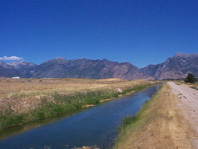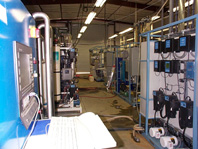Water Treatment Pilot Study
The study will determine if enhanced conventional treatment or membrane technology will be used in new water treatment plant.
LeRoy W. Hooton, Jr.
July 31, 2001
|
|
When the new treatment plant is completed, it will provide Salt Lake City and Sandy City an adequate drinking water supply to the year 2025. Moreover, the strategically located plant will provide treated drinking water to other water entities as well. The Jordan Valley Water Conservancy District will purchase treated water from the plant to meet the growing water demands of its customer agencies in Salt Lake County. The Central Utah Water Conservancy District is considering acquiring capacity for future water deliveries into northern Utah County.
Named Point of the Mountain Water Treatment Plant (POMWTP), the plant is being built under an agreement inked in April by the district, Salt Lake City and Sandy City. The estimated $125 million price tag is being paid for by the two cities based on the capacity each receives. Bond payments will be made through a new capacity assessment made to each city. According to general manager Nick P. Sefakis, the plant is scheduled for completion in 2006.
The sources of water for the POMWTP are the Provo River Project and Central Utah Project with storage in Deer Creek and Jordanelle Reservoirs, respectively. When POMWTP is constructed, water released from these storage projects will flow down the Provo River to the Murdock and Provo Reservoir Canal diversion at the mouth of Provo Canyon. From this diversion, the water travels about 15 miles northwest in the canal until it reaches a new diversion point near the Point of the Mountain and I-15 in Lehi City, Utah County. The water will then be conveyed northward by pipeline to the new POMWTP on the Salt Lake County side of the county dividing line.
The pilot plant is housed in an inconspicuous building located near farm fields in Lehi City. Nearby new subdivisions are replacing the farmlands, reflecting the growth taking place in northern Utah County. The pilot plant consists of a series of skid-mounted treatment processes that will ultimately determine the treatment process for the POMWTP. “Three treatment trains are being tested,” says MWDSLS engineer Marie Owens. “The purpose of the pilot study is to determine the type of treatment process to be used in the full scale water treatment plant and acquire data for design specifications.” The pilot testing is required by the state Division of Drinking Water as part of the treatment process and construction approval process.
The engineering firms of Carollo Engineers and McGuire Environmental Consultants have been hired to conduct the $1.58 million pilot study. Pilot work has been underway since May and will continue until September using water from the Provo Reservoir Canal. During the winter months the water source will be taken from the Jordan Aqueduct. This water is diverted from the Provo River at the Olmsted intake. The pilot study will continue for an additional 5-months taking water from the aqueduct.
The advantage of the pilot plant is that on a small scale, data can be obtained that simulates full scale plant treatment performance. The pilot plant only treats about 80 gallons per minute; however, the performance data will provide the necessary information to build a water treatment plant that will treat 50,000 gallons per minute of water.
|
|
- Conventional pretreatment (chemical addition, rapid mix, flocculation and sedimentation) followed by micro/ultrafiltration membranes.
- Presedimentation (raw water storage) followed by micro/ultrafiltration followed by granular activated carbon.
- Conventional pretreatment followed by ozonation, biologically active filters and UV disinfection (that will be conducted in a later study)
The key finished water quality goals are turbidity/solids < 0.1 NTU, 95 percent of the time, not to exceed 0.3 NTUs; Cryptosporidium 3 log removal/inactivation; and viruses 4 log removal/inactivation. In anticipation of more stringent Disinfection By-product standards, the pilot goal is to achieve values 50 percent of the current standards. The treated water must meet acceptable aesthetic standards with no objectionable taste, odor or color.
Conventional water treatment has been used in Salt Lake County since 1953 when Salt Lake City constructed the 20 million gallon per day City Creek Water Treatment Plant. Today, all of the water treatment plants that provide drinking water to Salt Lake County residents have relied on conventional treatment technology. But since the 1992 Milwaukee Cryptosporidium water borne disease outbreak, the water industry has become ever more concerned about chlorine resistant pathogens, particularly Cryptosporidium. Membrane technology appears to have the edge in removing this organism, which is currently driving drinking water regulations. However, conventional treatment processes enhanced with ozone or ultraviolet disinfection may be equally as effective.
According to the American Water Works Association Research Foundation (Foundation), the definition of a membrane is “a thin layer of material that is capable of separating materials as a function of their physical and chemical properties when driving force is applied across the membrane.” Membranes resemble extremely small tubes (hollow fibers) that water is forced through by either vacuum or pressure, straining out certain unwanted materials. Reverse Osmosis (RO) is the best known type of membrane. RO processes are used extensively for desalination of seawater. The introduction of a wide-range of municipal water treatment membranes is just beginning to be considered as an alternative to conventional water treatment technology.
There are numerous types and manufacturers of membrane treatment systems. During the past decade the use of membranes has grown in popularity, particularly for treating brackish well water. The Foundation notes that there is growing interest in using membranes to replace conventional filter beds in municipal water treatment plants. “In 1996 there were approximately 30 plants in operation or under construction with a capacity of 60,000 cubic meters per day (16 million gallons per day).”
|
|
Even nationally, there is a dearth of large membrane water treatment plants to measure long term performance. San Antonio, Texas (Bexar Metropolitan Water District) is touted as the first surface water ultrafiltration plant to be constructed in the United States with a 9.0 million gallon per day treatment capacity. “No plant of this size (POMWTP) in the United States is currently using membrane technology,” says Owens. “However several large scale membrane treatment projects are currently in design and will probably be online prior to the POMWTP completion date.” This of course assumes that the membrane technology is chosen as the treatment process for the new plant. There are strengths and weaknesses of both conventional and membrane treatment processes. That’s why the pilot study. Data and experience gained from the study will help MWDSLS determine which process will produce the most cost-effective and best quality water.
Besides evaluating each pilot process, operation and maintenance costs, capital costs and waste disposal will be part of the cost analysis leading to selecting the final treatment process.
A technical advisory team is working with MWDSLS to help decide on which treatment process to use. The team consists of technical experts from other water treatment facilities along the Wasatch Front.
Will new membrane technology be chosen for the POMWTP or will enhanced conventional treatment technology? “It may come down to dollars,” notes Owens, whose job is to impartially collect the data necessary to make the decision.


